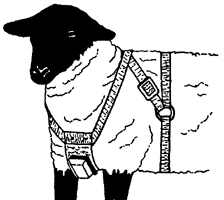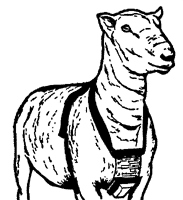- Shear all rams, if the season of the year permits. This will help them on
hot, humid days.
- Trim their feet well in advance.
- The previous year’s rams and bucks need to be placed on a weight gaining
program:
- 1st choice - good, green pasture, i.e. mixed legume-grass.
- 2nd choice - good, clean grain at the rate of 1 - 2 lbs/head/day and
an ample supply of good quality, legume hay.
- A breeding soundness evaluation (BSE) should be performed on every ram and
buck. This exam should include a thorough semen evaluation. See B710
for additional information on performing a BSE.
Employment of Teaser Rams or Bucks: "Teaser" rams/bucks are
animals that have been surgically altered in a way that prevents them from
reproducing. These animals still have sexual drive and will mount females in
heat. Some producers will use a marking harness on the teaser ram/buck to mark
the ewes/does that are cycling. These animals can also be used to help get a
group of females cycling at roughly the same time. Estrus synchronization can
also be accomplished by having rams/bucks in a pasture, paddock, or pen next to
the group of ewes/does. The sight, sound, and particularly smell of the ram/buck
will often be enough to synchronize the cycling of the females. The use of
teaser rams/bucks should not begin more than two (2) weeks prior to the start of
the breeding season.
|
|
|
A
typical marking harness on a teaser ram. |
|
Ram/Buck Usage During the Breeding Season: The following are common
ratios of females to males:
Ratio of Ewes per Ram or Does per Buck:
- Ram lambs and buck kids (approx. 8-10 months of age):
- 15 to 30 ewes or does per 1 ram lamb or buck kid.
- Yearlings (approx. 12-16 months of age):
- 25 to 50 ewes or does per 1 yearling ram or buck.
- Mature rams and bucks:
- a general rule is 100 ewes or does per 2.5 to 3 rams or bucks.
There are 5 ways of utilizing a ram or buck during the breeding season:
- Continuous Service: This is where the rams/bucks are simply
turned in with the females at all times during the breeding season.
- Intermittent Service: The rams/bucks are turned in for only a
portion of the time, usually at night. This is an excellent way to use ram
lambs and yearlings who will have a tendency to overwork themselves. This
also makes it easier to supplement the ram(s) and buck(s). When the male is
not with the females, leave a bred female or wether in with the ram/buck for
company.
- Rotational Service: This is a method of using different
rams/bucks at different times during the season. Use of the
rotational plan is recommended when young males constitute a portion of the
ram/buck battery. Rotational servicing helps to prevent the younger males
from overworking themselves.
- The 1/2 and 1/2 system - turn-out 1/2 of the rams/bucks for about 3
weeks and then bring them in. Turn out the other 1/2 of the ram/buck
battery for the remaining time.
- Another method is to use 1/3 of the rams/bucks for the first two
weeks, then remove them. At that time, introduce the other 2/3rds of the
ram/buck battery for the next 2 weeks. After the 2 weeks, then add the
initial 1/3rd of the rams/bucks so that all males are in for a final 2
weeks.
- Hand Coupling/Hand Mating Service: This involves taking the ewes
or does as they come into heat to the flock ram/buck for servicing. This can
be good for purebred breeding in order to extend the service of an old or
infirm ram/buck. However, because of the necessity for heat detection, it
requires the use of additional heat detection methods such as a teaser
ram/buck and apron. Failure of adequate heat detection is the primary reason
this method may be unsuccessful.
- Artificial Insemination Service: This system requires that
efficient heat detection methods be utilized. Currently, this method is not
being used to any great extent in large commercial sheep production systems
because of the extensive labor and management issues that are involved.
However, many of the small and mid-sized goat and sheep producers
successfully utilize this method for genetic improvement in the flock/herd.
Both frozen and fresh semen are commonly used for breeding.
* See page B710 for additional information on reproduction.

